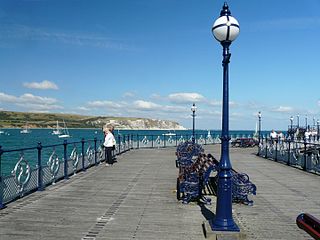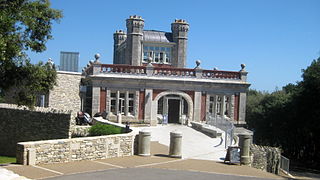
Swanage Museum & Heritage Centre is a local history museum and family history centre in Swanage, Dorset. The museum was established in 1976; it merged with and has been collocated with the heritage centre in its current location since 2005.

Swanage Museum & Heritage Centre is a local history museum and family history centre in Swanage, Dorset. The museum was established in 1976; it merged with and has been collocated with the heritage centre in its current location since 2005.
The museum was established in 1976 by David Florence and Phyllis Mapley [1] [2] and was known as the Tithe Barn Museum & Art Centre. [3] The museum had exhibits relating to Swanage and Purbeck, including geology, local history, archaeology, maritime and stone quarrying. [4]
The tithe barn is Grade II listed and is built of Purbeck stone. [5] The listing entry describes the barn as 18th-century, although the local historian David Lewer attributed it to the 16th-century. [6] The museum was held on a 99-year peppercorn lease. [7] Since the museum vacated the tithe barn in 2005, it has become a private residence.
The heritage centre was located in the old market building on the seafront, built in the 1890s. [8] The remnants of the Swanage Pier Tramway commence on the footway adjacent to the old market building.
In 2005 the museum was forced to leave its home in the tithe barn due to deathwatch beetle in the roof which it could not afford to repair, and merged with the Heritage Centre in The Square. [9] [10] It moved into an area of the Heritage Centre that had formerly been dedicated to showing a film about Swanage. [11] The combined facility was opened in 2006. [12]
Until 2010 the museum was staffed by employees of the then Purbeck District Council, but budgetary constraints mean that the museum is now run by volunteers. [13] It has two other sites apart from the main site which is open to the public. [14] The other two sites are the local studies centre at Marine Villas on Swanage Pier and a climate-controlled family history storage facility on a local industrial estate. [15] Until 2015, the storage facility was held at Belle Vue Farm. [16]
The curator (2015) is David Haysom. [17] The museum has exhibits on fossils, the fishing industry, Purbeck stone, and a number of Victorian shop fronts. [18]

Corfe Castle is a village and civil parish in the English county of Dorset. It is the site of a ruined castle of the same name. The village and castle stand over a gap in the Purbeck Hills on the route between Wareham and Swanage. The village lies in the gap below the castle and is around four miles (6.4 km) south-east of Wareham, and four miles (6.4 km) north-northwest of Swanage. Both the main A351 road from Lytchett Minster to Swanage and the Swanage Railway thread their way through the gap and the village.

Kimmeridge is a small village and civil parish on the Isle of Purbeck, a peninsula on the English Channel coast in Dorset, England. It is situated about 4.5 miles (7.2 km) south of Wareham and 7 miles (11 km) west of Swanage. In 2013 the estimated population of the civil parish was 90.

Swanage is a coastal town and civil parish in the south east of Dorset, England. It is at the eastern end of the Isle of Purbeck and one of its two towns, approximately 6+1⁄4 miles (10 km) south of Poole and 25 miles (40 km) east of Dorchester. In the 2011 census the civil parish had a population of 9,601. Nearby are Ballard Down and Old Harry Rocks, with Studland Bay and Poole Harbour to the north. Within the parish are Durlston Bay and Durlston Country Park to the south of the town. The parish also includes the areas of Herston, just to the west of the town, and Durlston, just to the south.

The Isle of Purbeck is a peninsula in Dorset, England. It is bordered by water on three sides: the English Channel to the south and east, where steep cliffs fall to the sea; and by the marshy lands of the River Frome and Poole Harbour to the north. Its western boundary is less well defined, with some medieval sources placing it at Flower's Barrow above Worbarrow Bay. John Hutchins, author of The History and Antiquities of the County of Dorset, defined Purbeck's western boundary as the Luckford Lake steam, which runs south from the Frome. According to writer and broadcaster Ralph Wightman, Purbeck "is only an island if you accept the barren heaths between Arish Mell and Wareham as cutting off this corner of Dorset as effectively as the sea." The most southerly point is St Alban's Head.

Durdle Door is a natural limestone arch on the Jurassic Coast near Lulworth in Dorset, England. It is privately owned by the Weld Family who own the Lulworth Estate, but it is also open to the public.

Worth Matravers is a village and civil parish in the English county of Dorset. The village is situated on the cliffs west of Swanage. It comprises limestone cottages and farm houses and is built around a pond, which is a regular feature on postcards of the Isle of Purbeck.

The Swanage Railway is a railway branch line from near Wareham, Dorset to Swanage, Dorset, England, opened in 1885 and now operated as a heritage railway.

Swanage Pier is a Victorian pier which extends into the southern end of Swanage Bay near the town of Swanage, in the south-east of Dorset. It was built in 1895 for passenger ship services. It is situated on the eastern coast of the Isle of Purbeck, approximately 6+1⁄4 miles (10.1 km) south of Poole and 25 miles (40 km) east of Dorchester in the United Kingdom.

Swanage railway station is a railway station located in Swanage, on the Isle of Purbeck in the English county of Dorset. Originally the terminus of a London and South Western Railway (L&SWR) branch line from Wareham, the line and station were closed by British Rail in 1972. It has since reopened as a station on the Swanage Railway, a heritage railway that currently runs from Norden station just north of Corfe Castle to Swanage station. It now also runs to Wareham on certain services, but not on regular services due to signalling problems.

Corfe Castle railway station is a railway station located in the village of Corfe Castle, in the English county of Dorset. Originally an intermediate station on the London and South Western Railway (L&SWR) branch line from Wareham to Swanage, the line and station were closed by British Rail in 1972. It has since reopened as a station on the Swanage Railway, a heritage railway that runs regularly from Norden station just north of Corfe Castle to Swanage station. The line also connects Wareham and Norden.

Norden railway station is a railway station located one mile to the north of the village of Corfe Castle, on the Isle of Purbeck in the English county of Dorset. It is situated on the Swanage Railway, a heritage railway that operates over the former London and South Western Railway line from Wareham to Swanage. Norden is the northern terminus of the railway's steam service from Swanage, and an intermediate stop on the railway's diesel hauled service that connects Swanage with the national rail network at Wareham station.

Tilly Whim Caves consists of three stone quarries in Durlston Country Park, 1 mile (1.6 km) south of Swanage, on the Isle of Purbeck, in Dorset, southern England. The Tilly Whim Caves are a part of the Jurassic Coast.

The Middlebere Plateway, or Middlebere Tramway, was a horse-drawn plateway on the Isle of Purbeck in the English county of Dorset. One of the first railways in southern England and the first in Dorset, the plateway was built by Benjamin Fayle, who was a wealthy Irish Merchant based in London and a friend of Thomas Byerley - Josiah Wedgwood's nephew. It was intended to take Purbeck Ball Clay from his pits near Corfe Castle to a wharf on Middlebere Creek in Poole Harbour, a distance of some 3.5 miles (5.6 km).

The Swanage Pier Tramway was a narrow gauge tramway in the port town of Swanage, in the English county of Dorset. It opened about 1858 and closed in the 1930s.

The Great Globe at Swanage is one of the largest stone spheres in the world and stands at Durlston Castle within Durlston Country Park, a 113-hectare (280-acre) country park and nature reserve. It is constructed of Portland stone, weighs about 40 tonnes and is 3 metres (10 ft) in diameter.

Durlston Castle stands within Durlston Country Park, a 1.13 square-kilometre (280-acre) country park and nature reserve stretching along the coastline south of Swanage, on the Isle of Purbeck in Dorset.
David James Lewer was an English author, architect, historian and choral musician.

Swanage Town Hall is a municipal building on Swanage High Street in Dorset. Constructed by the local building contractor George Burt in 1882–83, it reused materials salvaged from demolition works in London. The façade was rescued from London's 17th-century Mercers' Hall and the external clock is dated to 1826. It was not universally welcomed and one critic in the 1930s described it as "positively dreadful". The hall serves as the chamber for the current town council and has previously hosted the magistrates' court, fire brigade and citizens' advice service.
The Prince Albert Memorial is a memorial in Swanage, Dorset in the form of a stone obelisk to Prince Albert, the consort of Queen Victoria, who died in 1861. The memorial was erected in 1862, and is notable for having been the earliest civic memorial to the Prince. It was dismantled in 1971, and only rebuilt 50 years later, in 2021.

St Mary's Church is a parish church in Swanage, Dorset. It is dedicated to the Virgin Mary. The church is in the Archdeaconry of Dorset, in the Diocese of Salisbury. The tower is mediaeval; the church itself is a 19th and early 20th-century reconstruction. It is Grade II listed.